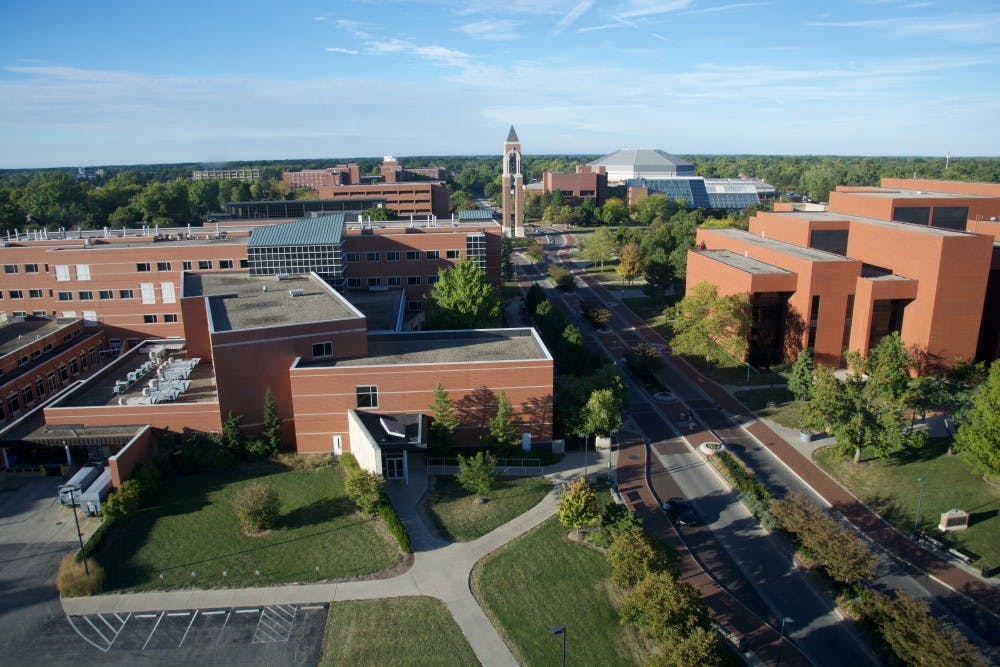With this in mind, Ball State could use sustainability as a tool to recruit students.
Ball State is one of 94 schools in the nation — and the only school in Indiana — to win a gold rating for sustainability from the Association for the Advancement of Sustainability in Education.
Ball State is also No. 50 in Princeton Review’s Top 353 greenest schools in the nation and outranks all other schools in Indiana on Princeton Review’s list.
The university has been granted seven awards for sustainability efforts since 2000 and more than 16 honors since 2001, according to the 2015 Ball State Sustainability Guide.
Colleges that practice sustainability create a high quality of life for the students, according to a report from the Massachusetts Executive Office of Energy and Environmental Affairs.
Christopher Munchel, associate vice president of enrollment services and director of undergraduate admissions, said the university works to highlight sustainability efforts when recruiting students.
Some sustainability efforts the university brings up in discussion with interested students include the geothermal system, which is the largest of its kind in the world, and the university’s LEED certified buildings.
But Ball State’s national leadership in sustainability may not be as visible as it could be. There is only one mention of Ball State’s sustainability efforts in the “Ball State University Official Self-Guided Tour” handout, and it’s of the Letterman Communication and Media Building, which has a Silver LEED rating.
At least eight buildings on campus have LEED certification, including Park Hall, DeHority Complex, the Jo Ann Gora Student Recreation and Wellness Center, Kinghorn Hall, Studebaker East, the District Energy Station North and the Marilyn K. Glick Center for Glass. At least three more buildings are up for LEED certification.
“Sustainability is such a strength of Ball State and a way for it to differentiate itself in an excellent way from other universities in Indiana and across the nation,” said John Vann, the green initiatives coordinator for Council on the Environment. “I wish we emphasized our leadership role in sustainability more in the recruitment materials we use with high school students.”
Students indicating an interest in attending sustainable schools is driving colleges to create programs that offer training in sustainability, David Soto of The Princeton Review said in a 2009 USA Today article.
“A lot of students are concerned about sustainability and expect [instructors] to be aware of their expectations and provide what we can to meet their expectations,” said Kevin Kenyon, the former associate vice president of facilities planning and management at Ball State, who now works with the vice president of business affairs on special sustainability projects.
Ball State has offered a minor in sustainability for undergraduate students since 2011.
As of the May 2016, 67 students will have graduated with a minor in sustainability.
Ball State is working on offering a major in sustainability, as well as a master’s degree in sustainability and a sustainability certificate for working professionals.
Any degrees in sustainability at Ball State will involve cross-disciplinary study because it will take people from all disciplines to achieve a sustainable future, said Melinda Messineo, chairwoman of the Department of Sociology and member of the Sustainability Degree Task Force.
Robert Koester, chairman of Ball State Council on the Environment, said America needs leaders who can shepherd the development of carbon-free, social, economic and environmental future.
“Sustainability education offers the breadth of exposure and skillsets needed to provide that very challenging, exciting, and rewarding leadership,” he said.
High school students interested in sustainability are strong candidates for admission to college, according to a 2014 Journal of College Admissions study done by Colorado State researcher Rodolfo Valdes-Vasquez.
Valdes-Vasquez’s found the students “more interested in sustainability,” referred to as MIS students, were:
- More likely to be female.
- More racially diverse.
- Higher achievers on standardized tests.
- More likely to have had their career choice influenced by biology or chemistry teachers in high school.
The majority of the MIS students want to directly address poverty, and are more likely to want to address other issues related to sustainability, particularly climate change and environmental degradation.
A report released by the National Association of Scholars in New York City said sustainability is part of the new college culture. Sustainability includes a grab bag of social issues, such as:
- Gender-neutral campus housing for transgender students.
- Patronizing women-owned businesses.
- Denouncing “white privilege” and police brutality.
The sustainable culture concept links the old, familiar liberal causes of environmental activism with a progressive take on social justice, Valdez-Vasquez said, which summarizes the interests of MIS students.
“The social benefits of identifying pro-sustainability students are numerous,” Valdes-Vasquez said. “Better educating these students will lead to future professionals who will improve the quality of life, health and well-being of our communities and nations.”





